- 1/2 lb italian sausage
- 1/2 c chopped green pepper
- 1/2 c chopped onion
- 1 can tomatoes, drained
- 1/2 loaf italian bread
- 3 eggs
- 2 1/2 c milk
- salt
- parmesan
- garlic powder
- Brown sausage for ten minutes.
- Add veggies and cook for five minutes.
- Add garlic and tomatoes and cook for fifteen minutes.
- Slice bread and put half the slices in the bottom of the buttered pan.
- Spread meat mixture on the slices of bread.
- Top with remaining slices of bread.
- Beat eggs in a bowl and add milk and salt.
- Pour egg mixture over bread.
- Sprinkle with parmesan cheese.
- Refrigerate for one hour or overnight.
- Bake for one hour at 325 degrees.
Experience
This recipe definitely turned out differently than intended. For starters, smoked sausage was used instead of italian sausage. So instead of browning the sausage for ten minutes, I boiled it for 10-12 minutes, cut it up into slices, then added it to the veggies, and continued with the recipe as normal from there. I ran out of time when it came to cooling the dish for an hour in the fridge. Since I was short on time, I improvised by putting it in the freezer for about twenty minutes. I also substituted garlic powder with garlic salt since I did not have any powder. I'm not sure how much of a difference the garlic salt and freezing instead of refrigerating made since I have never eaten this dish before. For this recipe, I did not even have a picture to go off of. I am curious how different this dish would be if it had italian sausage in it instead of smoked sausage. I can say this is the first dish I had throughout this blogging experience that I did not care for. The bottom layer of bread got soggy, and I did not care for the egg mixture in it as well.
Origins: Strata
Strata is an American-made dish with "strata" meaning "many layers." It became popular around World War 2 when many women were going to work, and they needed food that could be prepared ahead of time. However, it can be made in one day or prepped ahead of time. Information from: http://almostitalian.com/strata/






